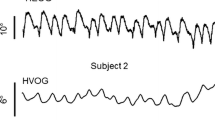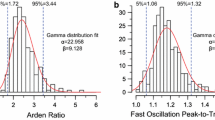Summary
The influence of age on optokinetic nystagmus (OKN) was studied in 63 healthy subjects, who were divided into three groups according to their age, group I (20–39 years), 11 (40–59 years) and III (60–82 years). It was found that on average maximal OKN velocity decreases considerably with age, from 114°/s in group I to 93°/s in group II and 73°/s in group III.
Two mechanisms participate in the generation of OKN, the so-called ‘fast’ component and ‘velocity storage’ component. The ‘fast’ component leads to immediate changes in slow phase nystagmus velocity and is related to smooth pursuit eye movements. The ‘velocity storage’ component causes more gradual velocity changes and expresses itself during optokinetic afternystagmus (OKAN). To study the relative contribution of these two components, maximal smooth pursuit and OKAN velocity were determined in addition to the maximal OKN velocity for the same individuals. It was found that both smooth pursuit and OKAN performance decrease with age. Consequently the maximal OKN velocity, which depends on both factors, is even more affected than smooth pursuit eye movements.
Similar content being viewed by others
References
Barnes GR, Hill T (1984) The influence of display characteristics on active pursuit and passively induced eye movements. Exp Brain Res 56:438–447
Boyle R, Büttner U, Markert G (1985) Vestibular nuclei activity and eye movements in the alert monkey during sinusoidal optokinetic stimulation. Exp Brain Res 57:362–369
Brandt Th, Büchele W (1983) Augenbewegungsstbrungen. Gustav Fischer Verlag, Stuttgart
Brandt Th, Dichgans J, Büchele W (1974) Motion habituation: Inverted self-motion perception and optokinetic after-nystagmus. Exp Brain Res 21:337–352
Büttner U, Waespe W, Henn V (1976) Duration and direction of optokinetic after-nystagmus as a function of stimulus exposure time in the monkey. Arch Psychiatr Nervenkr 222:281–291
Büttner U, Meienberg O, Schimmelpfennig B (1983) The effect of central retinal lesions on optokinetic nystagmus in the monkey. Exp Brain Res 52:248–256
Büttner U, Waespe W (1984) Purkinje cell activity in the primate flocculus during optokinetic stimulation, smooth pursuit eye movements and VOR-suppression. Exp Brain Res 55:97–104
Cohen B, Matsuo V, Raphan T (1977) Quantitative analysis of the velocity characteristics of optokinetic nystagmus and optokinetic after-nystagmus. J Physiol 270:321–344
Collewijn H (1969) Optokinetic movements in the rabbit: Input-output relations. Vision Res 9:117–132
Dichgans J, Kolb B, Wolpert E (1974) Provokation optokinetischer Seitendifferenzen durch Einschränkung der Reizfeldbreite and ihre Bedeutung für die Klinik. Arch Psychiatr Nervenkr 219:117–131
Dichgans J, Reutern GM v, Römmelt U (1978) Impaired suppression of vestibular nystagmus by fixation in cerebellar and non-cerebellar patients. Arch Psychiatr Nervenkr 226:183–199
Gonshor A, Malcolm R (1971) Effect of changes in illumination level on electro-oculography (EOG). Aerospace Med 42:138–140
Jung R, Kornhuber HH (1964) Results of electronystagmography in man: The value of optokinetic, vestibular, and spontaneous nystagmus for neurological diagnosis and research. In: Bender MB (ed) The oculomotor system. Harper and Row, New York, pp 428–488
Keller EL, Precht W (1978) Persistence of visual response in vestibular nucleus neurons in cerebellectomized cat. Exp Brain Res 32:591–594
Lisberger SG, Evinger LC, Johanson GW (1977) Smooth pursuit tracking of periodic and non-periodic targets in man. Soc Neurosci Abstr 3:156
Robinson DA (1981) Control of eye movements. In: Brooks VB (ed) Handbook of physiology, section 1: The nervous system, vol II, part 2. American Physiological Society, Bethesda, Maryland, pp 1275–1320
Sharpe JA, Sylvester TO (1978) Effect of aging on horizontal smooth pursuit. Invest Opthalmol 17:465–468
Spooner JW, Sakala SM, Baloh RW (1980) Effect of aging on eye tracking. Arch Neurol 37:575–576
Ter Braak JWG (1936) Untersuchungen über optokinetischen Nystagmus. Arch Neerl Physiol 21:309–376
Waespe W, Henn V (1977a) Neuronal activity in the vestibular nuclei of the alert monkey during vestibular and optokinetic stimulation. Exp Brain Res 27:523–538
Waespe W, Henn V (1977b) Vestibular nuclei activity during optokinetic after-nystagmus (OKAN) in the alert monkey. Exp Brain Res 30:323–330
Waespe W, Henn V (1981) Visual-vestibular interaction in the flocculus of the alert monkey. II. Purkinje cell activity. Exp Brain Res 43:349–360
Waespe W, Huber Th, Henn V (1978) Dynamic changes of optokinetic after-nystagmus (OKAN) caused by brief visual fixation periods in monkey and man. Arch Psychiatr Nervenkr 226:1–10
Waespe W, Büttner U, Henn V (1981) Visual-vestibular interaction in the flocculus of the alert monkey. I. Input activity. Exp Brain Res 43:337–348
Author information
Authors and Affiliations
Additional information
Supported by Deutsche Forschungsgemeinschaft SFB 200, A2
Rights and permissions
About this article
Cite this article
Simons, B., Büttner, U. The influence of age on optokinetic nystagmus. Eur Arch Psychiatr Neurol Sci 234, 369–373 (1985). https://doi.org/10.1007/BF00386053
Issue Date:
DOI: https://doi.org/10.1007/BF00386053




